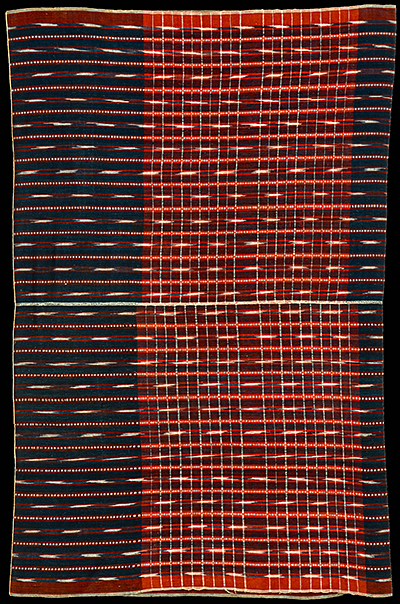| |
 
 | | | |
260 Moluccas, Halmahera
Ba'a boba (sarong)  
| | Locale: | Used by Sahu people on Halmahera, but made by Butonese, perhaps on Buton but more likely in Butonese settlement on Halmahera or Ternate. | | Period: | Circa 1900 | | Yarn: | Cotton, hand-spun, fine | | Technique: | Warp ikat in medium cotton and supplementary weft | | Panels: | 2 | | Size: | 75 x 115 cm (2' 5" x 3' 9") LW: 1.53 | | Weight: | 445 g (15.7 oz), 258 g/m2 (0.85 oz/ft2) | | Design: | Twelve narrow bands per panel decorated with white on indigo ikat offset by red stripes. Only one side, the kepala or 'head', which is worn to the front, has the panel in red, the other, the body, is decorated in indigo only. The warp dashes in this piece, created by warp pulling on ikated indigo blocks, are archaic, early ikat motifs similar to those found in the textiles of Aceh, Batak, Pasemah, Bengkulu, Minangkabau, Ili Mandiri, Solor and Lembata, as well as in the narrow ikated stripes separating more elaborate figurative bands found on many other islands. The red kepala is further accentuated by narrow strips in supplementary weft. Note that the misalignment of the two panels is intentional. According to Sahu beliefs, proper alignment would invite serious misfortune. | | Comment: | Sarong used for harvest festival. While such sarongs are worn by women they are inherited along patrilineal lines. The Sahu people themselves no longer have any idea of the origin of such cloths. Ikats similar to these used to be made on the small island of Buton, off the southeastern tip of Sulawesi. The Butonese were sailors and traders who roamed the eastern islands, and established settlements on Halmahera and the smaller but more powerful Ternate that lies off Halmahera's southwestern shore. The cloths, only a small percentage of which were ikated, then were adopted by the Sahu people of western Halmahera for ceremonial use. As they are agriculturists who supplied the court of Ternate, and also served Ternate's higher classes in other capacities, such cloths may well have been given them as payment. As they differ from old Butonese cloths seen in museums, ba'a boba are likely to have been made to Sahunese specifications. A true pusaka in mint condition. Ex collection J.B. Lüth, who field-collected the piece in 1987. | | Background: | Chapters on Moluccas and Halmahera. | | Exhibited: | Roemer Museum, Hildesheim, 1991. Hong Kong University Museum and Art Gallery, 2017. | | Published: | Brigitte Khan Majlis, Woven Messages. HALI 192, 2017. Ikat Textiles of the Indonesian Archipelago, 2018.
| | Sources: | Depicted in Khan Majlis, Woven Messages, Fig. 323, (perhaps too) conservatively dated '1st half 20th c.'. A similar piece dated 'around 1900' is depicted in Khan Majlis, Indonesische Textilien, Abb. 757. Near identical to specimen in Wereldmuseum, Leiden, Acc. Nr. 7038-1. Niggemeier's article Ceramische Baumwoll- und Fasergewebe (1952: 3881 passim) is the only early source of information on these textiles. Important information is dericed from Leontine E. Visser, The Historical Paths of Sahu Ceremonial Textiles. | | |

©Peter ten Hoopen, 2025
All rights reserved.
|
|


